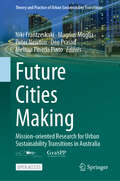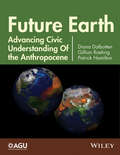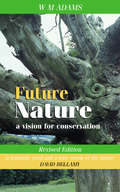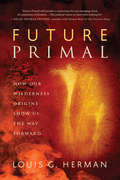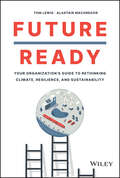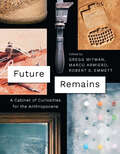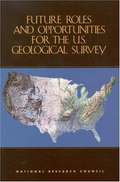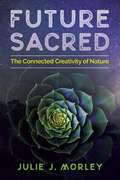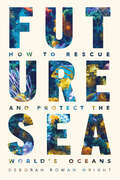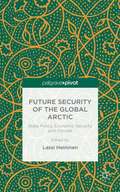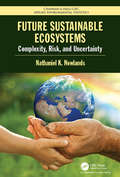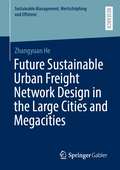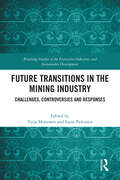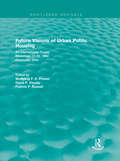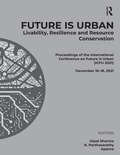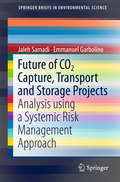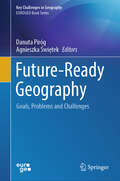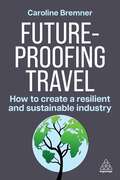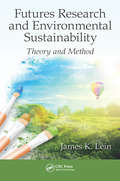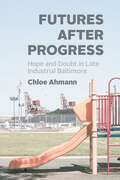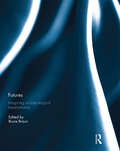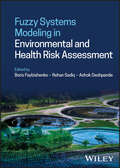- Table View
- List View
Future Cities Making: Mission-oriented Research for Urban Sustainability Transitions in Australia (Theory and Practice of Urban Sustainability Transitions)
by Niki Frantzeskaki Peter Newton Deo Prasad Magnus Moglia Melissa Pineda PintoThis open access book describes the complex dynamics that coevolve in cities and from cities, to inform agendas for urban research and urban policy with a view to future city missions. It provides a suite of research-informed chapters on urban pathways that are early signals and visions for how future cities can be shaped and transformed as well as chapters from policy, industry and intermediary organization actors that relate and respond to these pathways from a mainstreaming and implementation perspective. This edited collection intends to trigger and capture an ambitious transformative agenda amongst researchers and practitioners who have as their mission to shape urban futures. While there is proliferating literature on cities, urbanism and urban governance, this book offers a unique selling point – implying a research positioning point – to the field of sustainability transitions by intersecting research on urban sustainability transitions and missions-oriented research. The focus on the nexus of game-changers, pathways and innovations sets the book firmly in the leading edge of urban transitions research. The book engages with a breadth of disciplines including sustainability science, urban planning, urban design, mobility, energy, climate change science, urban ecology, urban sociology, architecture, data science, sustainability transitions studies, policy analysis and policy studies, as well as environmental governance. As an output, it aims to engage with and inspire future research and teaching/education in the fields of architecture and urban planning, urban design, environmental governance, sustainability science, innovation studies and urban sociology.
Future Directions in Energy Engineering: Challenges, Opportunities, and Sustainability (Green Energy and Technology)
by Xiaolin WangFuture Directions in Energy Engineering: Challenges, Opportunities, and Sustainability presents new advances and research results in theoretical, experimental, and practical sustainable energy engineering. Contributions cover case studies to explore and analyze technological advancements alongside practical applications to help readers better understand the relevant concepts and solutions necessary to achieve clean energy and sustainable development. The book brings together the latest developments in the emerging areas of intelligent power systems, green energy, and technology. Coverage includes: Electric power generation, transmission, and distribution; Power system economics, operation, and control; Energy storage and cybersecurity for smart grids; Energy efficiency in building designs and management; Sustainable materials for buildings; Integration of renewable energy sources in buildings; Greening urbanization and urban settlements. The book offers approaches to help engineers and researchers in sustainable energy engineering technologies solve practical problems affecting their daily work.
Future Drive: Electric Vehicles And Sustainable Transportation
by Daniel Sperling A. F. Burke Patricia M. Davis Mark A. DelucchiIn Future Drive, Daniel Sperling addresses the adverse energy and environmental consequences of increased travel, and analyzes current initiatives to suggest strategies for creating a more environmentally benign system of transportation. Groundbreaking proposals are constructed around the idea of electric propulsion as the key to a sustainable transportation and energy system. Other essential elements include the ideas that: *improving technology holds more promise than large-scale behavior modification *technology initiatives must be matched with regulatory and policy initiatives *government intervention should be flexible and incentive-based, but should also embrace selective technology-forcing measures *more diversity and experimentation is needed with regard to vehicles and energy technologies Sperling evaluates past and current attempts to influence drivers and vehicle use, and articulates a clear and compelling vision of the future. He formulates a coherent and specific set of principles, strategies, and policies for redirecting the United States and other countries onto a new sustainable pathway.
Future Earth: Advancing Civic Understanding of the Anthropocene
by Diana DalbottenEarth now is dominated by both biogeophysical and anthropogenic processes, as represented in these two images from a simulation of aerosols. Dust (red) from the Sahara sweeps west across the Atlantic Ocean. Sea salt (blue) rises into the atmosphere from winds over the North Atlantic and from a tropical cyclone in the Indian Ocean. Organic and black carbon (green) from biomass burning is notable over the Amazon and Southeast Asia. Plumes of sulfate (white) from fossil fuel burning are particularly prominent over northeastern North America and East Asia. If present trends of dust emissions and fossil fuel burning continues in what we call the Anthropocene epoch, then we could experience high atmospheric CO2 levels leading to unusual warming rarely experienced in Earth's history. This book focuses on human influences on land, ocean, and the atmosphere, to determine if human activities are operating within or beyond the safe zones of our planet's biological, chemical, and physical systems. Volume highlights include: * Assessment of civic understanding of Earth and its future * Understanding the role of undergraduate geoscience research and community-driven research on the Anthropocene * Effective communication of science to a broader audience that would include the public, the K-12 science community, or populations underrepresented in the sciences * Public outreach on climate education, geoscience alliance, and scientific reasoning Future Earth is a valuable practical guide for scientists from all disciplines including geoscientists, museum curators, science educators, and public policy makers. This volume was made possible with the support of the National Science Foundation through the National Center for Earth-surface Dynamics (EAR-0120914) and the Future Earth Initiative (DRL-0741760). Any opinions, findings, and conclusions or recommendations expressed in this publication are those of the author(s) and do not necessarily reflect the views of the National Science Foundation.
Future Nature: A Vision for Conservation
by W.M. AdamsThe countryside is changing faster than ever. Fifty years of conservation achievements in the UK are now being confronted by a new complexion of economic forces that are driving change in the countryside. At the same time new ideas in conservation are altering the role that conservation is being asked to play in negotiating the transition from past to future. This revised edition of Bill Adams classic work Future Nature tackles the new challenges in the countryside and wildlife conservation head-on through a new Introduction and Postscript with updated arguments about naturalness and our social engagement with nature, and complemented by a new Foreword by Adrian Phillips. Concepts such as biodiversity and sustainability, and changes in our understanding, appreciation and concern for nature, offer unprecedented opportunities. Bill Adams explores the scientific, cultural and economic significance of conservation. He argues that conservation must move beyond the boundaries of parks and reserves to embrace the whole countryside. The importance of conservation for the future is enormous. It holds the potential to create new spaces for nature, both in the landscape and in our lives and imaginations. This factual, beautifully written and thought-provoking book offers a fundamental reassessment of conservation, its importance, and how to achieve it. Published with BANC
Future Primal
by Louis G. HermanHow should we respond to our converging crises of violent conflict, political corruption, and global ecological devastation? In this sweeping, big-picture synthesis, Louis G. Herman argues that for us to create a sustainable, fulfilling future, we need to first look back into our deepest past to recover our core humanity. Important clues for recovery can be found in the lives of traditional San Bushman hunter-gatherers of South Africa, the closest living relatives to the ancestral African population from which all humans descended. Their culture can give us a sense of what life was like during the tens of thousands of years when humans lived in wilderness, without warfare, walled cities, or slavery. Herman suggests we draw from the experience of the San and other earth-based cultures and weave their wisdom together with the scientific story of an evolving universe to help create something radically new -- an earth-centered, planetary politics with the personal truth quest at its heart.
Future Ready: Your Organization's Guide to Rethinking Climate, Resilience, and Sustainability
by Tom Lewis Alastair MacGregorRethink climate, resilience, and sustainability for your organization In Future Ready: Your Organization’s Guide to Rethinking Climate, Resilience, and Sustainability, a team of business leaders with deep expertise in engineering, planning, finance, project, program implementation and advisory consulting perspective delivers an essential guide for executives, managers, and other business and infrastructure organization leaders to set and implement a resilience, sustainability and ESG strategy in complex project and operating environments. Through practical examples and proven insights, readers will learn to proactively engage with stakeholders, successfully plan, implement, and measure the impacts of their initiatives, and effectively communicate the results. In the book, the authors draw on hundreds of completed projects across a full range of client organizations, markets, sectors, and scales to equip readers with unprecedented insights and the behind-the-scenes work that went into making the projects successful. The authors also include: Strategies for identifying, cataloguing, and reporting risks—from the operational to the physical and transactional—as well as explanations of how climate risk scenarios can reveal hidden opportunities and unexpected vulnerabilities A Future Ready mindset and the specific examples of organizational sustainability and climate adaptation commitments and the paths companies have taken to meet their goals Critical questions that leaders must ask of themselves and their organizations before they begin a climate, resilience, and/or sustainability initiativeA must-read guide for executives, board members, ESG professionals, and other business and infrastructure organization leaders, Future Ready belongs in the hands of anyone who finds themselves responsible for helping an organization achieve their environmental, social, and governance goals.
Future Remains: A Cabinet of Curiosities for the Anthropocene
by Gregg Mitman Marco Armiero Robert EmmettWhat can a pesticide pump, a jar full of sand, or an old calico print tell us about the Anthropocene—the age of humans? Just as paleontologists look to fossil remains to infer past conditions of life on earth, so might past and present-day objects offer clues to intertwined human and natural histories that shape our planetary futures. In this era of aggressive hydrocarbon extraction, extreme weather, and severe economic disparity, how might certain objects make visible the uneven interplay of economic, material, and social forces that shape relationships among human and nonhuman beings? Future Remains is a thoughtful and creative meditation on these questions. The fifteen objects gathered in this book resemble more the tarots of a fortuneteller than the archaeological finds of an expedition—they speak of planetary futures. Marco Armiero, Robert S. Emmett, and Gregg Mitman have assembled a cabinet of curiosities for the Anthropocene, bringing together a mix of lively essays, creatively chosen objects, and stunning photographs by acclaimed photographer Tim Flach. The result is a book that interrogates the origins, implications, and potential dangers of the Anthropocene and makes us wonder anew about what exactly human history is made of.
Future Roles And Opportunities For The U.s. Geological Survey
by Committee on Future Roles Challenges Opportunities for the U.S. Geological SurveyThe National Academies Press (NAP)--publisher for the National Academies--publishes more than 200 books a year offering the most authoritative views, definitive information, and groundbreaking recommendations on a wide range of topics in science, engineering, and health. Our books are unique in that they are authored by the nation's leading experts in every scientific field.
Future Sacred: The Connected Creativity of Nature
by Glenn Aparicio Parry Julie J. MorleyReveals how our survival depends on embracing complexity consciousness and relating to nature and all life as sacred • Rejects the “survival of the fittest” narrative in favor of sacred symbiosis, creative cooperation, interdependence and complex thinking • Provides examples from complexity studies, cultural history, philosophy, indigenous spirituality, biomimicry, and ecology to show how nature’s intelligence and creativity abound everywhere • Documents how indigenous cultures lived in relative harmony with nature because they perceived themselves as part of the “ordered whole” of all life In Future Sacred, Julie J. Morley offers a new perspective on the human connection to the cosmos by unveiling the connected creativity and sacred intelligence of nature. She rejects the “survival of the fittest” narrative--the idea that survival requires strife--and offers symbiosis and cooperation as nature’s path forward. She shows how an increasingly complex world demands increasingly complex consciousness. Our survival depends upon embracing “complexity consciousness,” understanding ourselves as part of nature, as well as relating to nature as sacred. Morley begins by documenting how indigenous cultures lived in relative harmony with nature because they perceived themselves as part of the “ordered whole” of all life--until modernity introduced dualistic thinking, thus separating mind from matter, and humans from nature. The author deconstructs the fallacy behind social and neo-Darwinism and the materialist theories of “dead matter” versus those that offer a connection with the sentient mind of nature. She presents evidence from complexity studies, cultural history, philosophy, indigenous spirituality, biomimicry, and ecology, highlighting the idea that nature’s intelligence and creativity abound everywhere--from cells to cetaceans, from hydrogen to humans, from sunflowers to solar panels--and that all sentient beings contribute to the evolution of life as a whole, working together in sacred symbiosis. Morley concludes that our sacred future depends on compassionately understanding and integrating multiple intelligences, seeing relationships and interdependence as fundamental and sacred, as well as honoring the experiences of all sentient beings. Instead of “mastery over nature,” we must shift toward synergy with nature--and with each other as diverse expressions of nature’s creativity.
Future Sea: How to Rescue and Protect the World’s Oceans
by Deborah Rowan WrightA counterintuitive and compelling argument that existing laws already protect the entirety of our oceans—and a call to understand and enforce those protections. The world’s oceans face multiple threats: the effects of climate change, pollution, overfishing, plastic waste, and more. Confronted with the immensity of these challenges and of the oceans themselves, we might wonder what more can be done to stop their decline and better protect the sea and marine life. Such widespread environmental threats call for a simple but significant shift in reasoning to bring about long-overdue, elemental change in the way we use ocean resources. In Future Sea, ocean advocate and marine-policy researcher Deborah Rowan Wright provides the tools for that shift. Questioning the underlying philosophy of established ocean conservation approaches, Rowan Wright lays out a radical alternative: a bold and far-reaching strategy of 100 percent ocean protection that would put an end to destructive industrial activities, better safeguard marine biodiversity, and enable ocean wildlife to return and thrive along coasts and in seas around the globe. Future Sea is essentially concerned with the solutions and not the problems. Rowan Wright shines a light on existing international laws intended to keep marine environments safe that could underpin this new strategy. She gathers inspiring stories of communities and countries using ocean resources wisely, as well as of successful conservation projects, to build up a cautiously optimistic picture of the future for our oceans—counteracting all-too-prevalent reports of doom and gloom. A passionate, sweeping, and personal account, Future Sea not only argues for systemic change in how we manage what we do in the sea but also describes steps that anyone, from children to political leaders (or indeed, any reader of the book), can take toward safeguarding the oceans and their extraordinary wildlife.
Future Security of the Global Arctic: State Policy, Economic Security And Climate
by Lassi HeininenIn the globalized Arctic there has been a transformation from military security to human security. Climate change, the utilization of Arctic resources and other global challenges have caused the Arctic 'paradox' and a need to redefine security.
Future Sustainable Ecosystems: Complexity, Risk, and Uncertainty (Chapman & Hall/CRC Applied Environmental Statistics #11)
by Nathaniel K NewlandsFuture Sustainable Ecosystems: Complexity, Risk, Uncertainty provides an interdisciplinary, integrative overview of environmental problem-solving using statistics. It shows how statistics can be used to solve diverse environmental and socio-economic problems involving food, water, energy scarcity, and climate change risks. It synthesizes interdisciplinary theory, concepts, definitions, models and findings involved in complex global sustainability problem-solving, making it an essential guide and reference. It includes real-world examples and applications making the book accessible to a broader interdisciplinary readership. Discussions include a broad, integrated perspective on sustainability, integrated risk, multi-scale changes and impacts taking place within ecosystems worldwide. State-of-the-art statistical techniques, including Bayesian hierarchical, spatio-temporal, agent-based and game-theoretic approaches are explored. The author then focuses on the real-world integration of observational and experimental data and its use within statistical models.
Future Sustainable Urban Freight Network Design in the Large Cities and Megacities (Sustainable Management, Wertschöpfung und Effizienz)
by Zhangyuan HeThis book aims to investigate a long-term strategy for sustainable urban logistics. The literature evidence exhibits that considerable research on urban logistics lacks long-term planning and rarely considers the urban spatial development and integration of urban distribution innovations. Currently, 11 distribution innovations can be used for future sustainable urban freight transport. According to a systematic discussion, this book formulates the conceptual model of Sustainable Inner-urban Intermodal Transportation (SIUIT) for future urban logistics. Moreover, a comprehensive analysis illustrates that future integrations of distribution innovations comprise operational and technological integration. To this end, the morphological analysis method is employed to discuss their feasible solutions based on the SIUIT model. After that, combined with the trend exploration of urban spatial development on large- and megacities, this book constructs the 2.x Modula & Sustainable Urban Freight Network to improve the flexibility of the future sustainable logistics transformation.About the AuthorDr. rer. pol. Zhangyuan He graduated from the University of Bremen. He currently undertakes postdoctoral research at the School of Urban Planning and Design, Peking University.
Future Transitions in the Mining Industry: Challenges, Controversies and Responses (Routledge Studies of the Extractive Industries and Sustainable Development)
by Tuija Mononen Lasse PeltonenThis volume focuses on mining and the challenges for this industry as it transitions and evolves as the demand for products and responsible and sustainable mining ever increases.Mining is a prerequisite for modern society, yet the industry is often criticized for having many negative environmental and social impacts. The volume explores the challenges, controversies and responses that arise when a society is reliant on the products of mining to maintain their standard of living, yet are simultaneously calling for the implementation of sustainable practices, with many communities also being resistant to mining activities taking place in their own location. Many transitions which present a solution to one problem can often lead to new issues and developments elsewhere. For example, the electrification of vehicles will help to mitigate climate change, but this will simultaneously increase the demand for minerals required for batteries. The acceptance of, or resistance to, mining varies from location to location and across different scales, with key factors relating to the social and environmental impacts and the economic benefits. One common tension revolves around whether local communities really benefit economically from mining activities, and even if they do, they could now be negatively impacted by the digitization of the industry which will naturally lead to a reduction in the number of jobs. This volume explains how transitions of these types are inextricably linked by demand, acceptance and the perception of benefits, and that as the industry evolves, more tensions and controversies will develop.This book will be of great interest to scholars and students of mining and the extractive industries, transitions and sustainable development, as well as to professionals working in natural resource management.
Future Visions of Urban Public Housing: An International Forum, November 17-20, 1994 (Routledge Revivals)
by Wolfgang F. Preiser David P. Varady Francis P. RussellFirst published in 1994, this book brings together the papers presented at the International Forum on ‘Future Visions of Urban Public Housing’ held on November 17-20, 1994 in Cincinnati, Ohio. Participants included public housing officials, academics, practitioners and public housing residents who came together to debate, compare and analyse practices and issues in urban and public housing in industrialised nations. The 55 collected papers address the following key topics: public housing policy; comprehensive neighbourhood planning for public housing; public housing in the urban design context; quality of design standards and guidelines for public housing; resident participation and enhanced self-sufficiency in public housing; public housing alternatives; revitalising and rehabilitating public housing; the Elderly, Children, and special populations in public housing. The findings suggest new directions for policy and agendas for action.
Future is Urban: Proceedings of the International Conference on FUTURE IS URBAN: Livability, Resilience and Resource Conservation (ICFU 2021), December 16–18, 2021
by R. Parthasarathy Utpal SharmaCities have played an important role in our lives since the dawn of civilization. However, cities are slowly becoming overwhelmed and therefore intervention is desirable towards green, blue and egalitarian nature. Even with current urban issues, we must rise to the occasion as professionals to create cities that are social, cities that take care of the environment, and cities that are digital. Increased citizen participation is indispensable in this process. The ‘International Conference on Future is Urban (IFCU’ 21) Dec 16-18, 2021, Ahmedabad, India’, takes into account Livability, Resilience & Resource Conservation for planning Future and cities in future.
Future of CO2 Capture, Transport and Storage Projects: Analysis Using A Systemic Risk Management Approach (SpringerBriefs in Environmental Science)
by Emmanuel Garbolino Jaleh SamadiThis book presents a summary of a three-year research project on risk management for the Capture, Transport and Storage of CO2 (CTSC), offering an in-depth study on complex sociotechnical systems and systemic modeling. Approaching CTSC as a complex sociotechnical system, this book proposes systemic modeling as a decision-making aid. It offers a means of decision-making for the development of CTSC projects in the real-world context, where the future of the technology is uncertain. Risk management is considered as a means of control that can provide a control structure for the whole system.The risks associated with CTSC are not exclusively technical in nature; CTSC also faces a number of further uncertainties, from development to commercial scales.A major question concerning CTSC at the current scale of development is: "What are the factors explaining the success or failure of CTSC projects in different contexts?" In order to answer this question, the book proposes a systemic risk management framework based on the system dynamics and STAMP (Systems-Theoretic Accident Model and Processes) concepts.
Future-Ready Geography: Goals, Problems and Challenges (Key Challenges in Geography)
by Danuta Piróg Agnieszka ŚwiętekThis book presents research on how geography as a science, as a university degree and as a school subject can get ready for the “future.” Today's world is in a state of permanent and radical change which is affecting society, science and the economy in equal measure. The concurrent processes of globalisation, digitisation, and integration shape and constantly modify the development factors and generate multidirectional social changes. Growing global issues related to climate change, food security, depletion of conventional energy sources, conflicts and wars, refugee crisis and pandemic open up new issues for geographic investigations as well as reinforce the need to examine old research topics covering a variety of subdisciplines. That is why the term “future-ready” is being more frequently used in discourses on geographic research. In particular, geographic education at schools should be subject to discussion and reflection as this is where our learners are primed to understand the world around them. The chapters of this book spread the knowledge about the role of geography in preparing the society for the future. The book responds to environmental, socio-economic, and political issues of global, regional and local impact. It provides methods, techniques and tools of data collection and analysis which efficiently support geographers in future-oriented research and help in forecasting environmental and social changes. Finally, this volume also discusses how to reinforce the position of geography as science and school subject today and in the future.
Future-proofing Travel: How to Create a Resilient and Sustainable Industry
by Caroline BremnerEvolving traveller expectations, pressures to reduce emissions and a need to preserve popular destinations from over-tourism and climate change are creating untold disruption in the travel industry. The industry cannot continue to grow unchecked and wholesale transformation is required.Future-proofing Travel considers current travel trends in consumer expectations for greener and more experiential travel alongside the demands from local communities and industry-led initiatives to meet government pledges of lower emissions. It explores how business leaders in tourism and hospitality services must adapt their offerings to remain relevant in a competitive environment where sustainability and technology are no longer nice-to-haves. Explore data-driven and holistic solutions for travel industry professionals to transform their businesses to be more purposeful and sustainable with this book.While there is no one pathway to success, Future-proofing Travel shows how travel companies and destinations are currently adapting their practices to be more impact conscious while also elevating the traveller experience. Using real-world examples from leading brands such as Airbnb, Marriott, TUI and Intrepid Travel, this book maps out how travel brands and destinations can accelerate their positive actions through digitalization and green innovation to regenerate local communities, retain consumer loyalty and increase long-term profits sustainably into the future.
Futures Research and Environmental Sustainability: Theory and Method
by James K. LeinThis book explores the challenges of presenting sustainability as a more actionable or practical concept and identifying approaches that might offer useful assistance in addressing the temporal and spatial representation of sustainability. The underlying premise of this book is that sustainability is a state realized in the future. In that future there is a geographic arrangement of society and economy that agrees with its environmental setting. This future perspective introduces a little examined subject area that can lend significant content to the sustainability challenge: Futures Research.
Futures after Progress: Hope and Doubt in Late Industrial Baltimore
by Chloe AhmannA powerful ethnographic study of South Baltimore, a place haunted by toxic pasts in its pursuit of better futures. Factory fires, chemical explosions, and aerial pollutants have inexorably shaped South Baltimore into one of the most polluted places in the country. In Futures after Progress, anthropologist Chloe Ahmann explores the rise and fall of industrial lifeways on this edge of the city and the uncertainties that linger in their wake. Writing from the community of Curtis Bay, where two hundred years of technocratic hubris have carried lethal costs, Ahmann also follows local efforts to realize a good future after industry and the rifts competing visions opened between neighbors. Examining tensions between White and Black residents, environmental activists and industrial enthusiasts, local elders and younger generations, Ahmann shows how this community has become a battleground for competing political futures whose stakes reverberate beyond its six square miles in a present after progress has lost steam. And yet—as one young resident explains—“that’s not how the story ends.” Rigorous and moving, Futures after Progress probes the deep roots of our ecological predicament, offering insight into what lies ahead for a country beset by dreams deferred and a planet on the precipice of change.
Futures: Imagining Socioecological Transformation
by Bruce BraunFutures: Imagining Socioecological Transformation brings together leading scholars to explore how we might know, enact, and struggle for, the conjoined social and ecological transformations we need to achieve just and sustainable futures. The question of transformation, and how it might be achieved, is explored across a variety of topics and geographical sites, and through heterodox analytical and theoretical approaches, in a collective effort to move beyond a form of critique that hands down judgements, to one that brings new ideas and new possibilities to life. Chapters are lively and original engagements with concrete situations that sparkle with creativity. Together, they add up to an impressive study of how to live, and what to struggle for, in the complex socioecological landscapes of the Anthropocene. This book was previously published as a special issue of the Annals of the Association of American Geographers.
Futurize! Dealing with Megatrends and Disruptors: A Handbook for the Future-Oriented CEO
by André de Waal Julie LinthorstThe future will bring only more megatrends and disruptions. With the guidance of this book, which centers around the authors’ years-of-research-backed high-performance organizations (HPO) framework and includes the unique self-assessment tool Futurize! Diagnosis, business leaders and organizations will be prepared and truly ‘future ready.’ The next two decades will present massive challenges for organizations, as they navigate the need for sustainable development against a complex backdrop of factors such as increasing inequality, resource scarcity, continued globalization, and the ever-increasing speed of technological advancement. This book will help business leaders and organizations set priorities and make decisions so that not only do they honor commitments to the United Nations Sustainable Development Goals, but also become more future ready by: identifying the megatrends and disruptors which impact organizations now and will in the future specifically outlining how those megatrends and disruptors will impact organizations showing how organizations can deal with this impact in practical terms. This book is a must for management teams, aspiring leaders, and professionals and students interested in the future of work, human resource management, and innovation.
Fuzzy Systems Modeling in Environmental and Health Risk Assessment (Water Resources Monograph)
by Boris Faybishenko Ashok Deshpande Rehan SadiqFuzzy Systems Modeling in Environmental and Health Risk Assessment Demonstrates the successful application of fuzzy systems modeling to real-world environmental and health problems In Fuzzy Systems Modeling in Environmental and Health Risk Assessment, a team of distinguished researchers delivers an up-to-date collection of the most successful and innovative attempts to apply fuzzy logic to problems involving environmental risk assessment, healthcare decision-making, the management of water distribution networks, and the optimization of water treatment and waste management systems. By explaining both the theoretical and practical aspects of using fuzzy systems modeling methods to solve complex problems, analyze risks and optimize system performance, this handy guide maintains a strongly application-oriented perspective throughout, offering readers a practical treatment of a cutting-edge subject. Readers will also find: Comprehensive explorations of the practical applications of fuzzy systems modeling in environmental science Practical advice on environmental quality assessments and human health risk analyses In-depth case studies involving air and water pollution, solid waste, indoor swimming pool and landfill risk assessments, wastewater treatment, and more Perfect for environmental engineers and scientists, Fuzzy Systems Modeling in Environmental and Health Risk Assessment will also benefit policy makers, computer scientists, mathematicians, and researchers and practitioners interested in applying soft computing theories to environmental problems.
